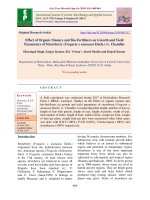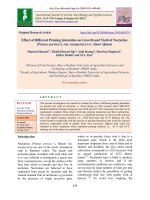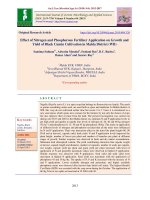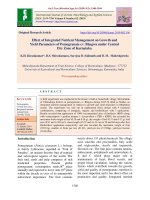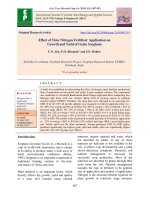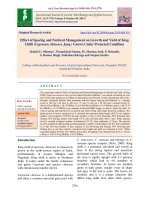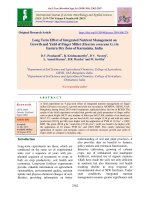Effect of time of planting on growth and yield parameters of potato crop
Bạn đang xem bản rút gọn của tài liệu. Xem và tải ngay bản đầy đủ của tài liệu tại đây (124.85 KB, 5 trang )
Int.J.Curr.Microbiol.App.Sci (2020) 9(5): 2847-2851
International Journal of Current Microbiology and Applied Sciences
ISSN: 2319-7706 Volume 9 Number 5 (2020)
Journal homepage:
Original Research Article
/>
Effect of Time of Planting on Growth and Yield Parameters of Potato Crop
Navneet Singh1*, Amandeep Singh2 and Kanwaljit Singh1
1
2
PG Department of Agriculture, Khalsa College Amritsar, India
Department of Plant Pathology, Punjab Agricultural University, Ludhiana, India
*Corresponding author
ABSTRACT
Keywords
Time of planting,
Growth and yield
parameters, Potato
crop
Article Info
Accepted:
23 April 2020
Available Online:
10 May 2020
To view the effect of different time of planting on growth and yield parameters of
potato (Solanum tuberosum L.) crop the experiments were conducted at Students
Research Farm, Khalsa College Amritsar. The experiments were conducted at four
different dates of planting as treatment viz., T1 (25 September), T2 (10 October)
and T3 (25 October) and T4 (10 November) each treatment replicated three times.
The data had been recorded at their respective stages of growth and total yield
were measured at the end of the season of the potato crop. It was found that
maximum no. of stems per hill was 6.9recorded in T2 treatment along with
maximum plant height T2 43.6 cm and maximum leaf area index 3.2 as compared
to other treatments. The maximum tuber yield was 218.9 q/ha and highest number
of tubers per plant 7.2 found in T2 treatment. The maximum tuber yield in 10
October sown crop due to optimum moisture and temperature condition along
with good growth of plants. Thus, 10th October date of planting is found to be
optimum for cultivation of potato crop in Amritsar district of Punjab.
Introduction
Potato (Solanum tuberosum L.) is the fourth
most important food crop in the world after
rice, wheat and maize in terms of production
(Razdan and Mattoo, 2005). Nutritionally
potato is rich in complex carbohydrates (61.591.5%) which is essential for energy, protein
(1.6 g), dietary fiber, vitamin C (25 mg),
starch (16.3 g) and minerals like phosphorus,
calcium and chlorine (Bose and Som, 1986).
The optimum growth and production is
largely depend upon prevailing weather
conditions and use of improved inputs like
use of improved varieties, time of planting,
good seed quality, time of planting and other
cultural practices till harvesting. Among
them, the optimum time of planting is major
limiting factor in maximum production of
potato. As the optimum time of planting result
in maximum germination, good crops stand
and better utilization of light and temperature
would enhance the yield. For best yields,
potato crop required long day conditions for
good growth and short day conditions for
tuberization (Chadha, 2009). Thus, the day
2847
Int.J.Curr.Microbiol.App.Sci (2020) 9(5): 2847-2851
length is another important factor for potato
(Cutter, 1992). Thus to find the optimum time
of planting the present study was conducted
during in main season in Amritsar (Punjab).
Materials and Methods
Location and climate
Amritsar is located at 31°-38' North latitude
and 74°-52' East longitude and altitude of 236
meters above sea level. The climate is
generally semi humid with extreme winters
and summers. The maximum temperature of
about 45-48°C is not uncommon during
summer,
while
freezing
temperature
accompanied by frost occurrence may be
witnessed in the months of December and
January annual rainfall 75 cm.
emergence as all treatment has statically
different value. Maximum number days taken
to emergence in treatment T4 (17.4 days) as
compare to T3 (16.2 days), T2 (15.0 days)
and T1 (14.2 days), respectively. But the T2
(10 October) gave maximum yield thus the 15
days period is optimum for good tuber
emergence. Similar findings were in
agreement with the earlier reported by Lal and
Sahota (1983) and Gopalakrishna (2007).
Number of stems per hill
The treatments were done on variety (Lady
Rosetta) at four different dates T1(25
September), T2 (10 October), T3 (25 October)
and T4 (10 November). The plot size was (3 x
3) m2. Plants in the central rows were used for
determination of agronomic performance,
leaving aside those in the two border rows as
well as those at both ends of each row to
avoid edge effects.
The data recorded for the number of stems per
hill at 60 days after sowing showed that time
of planting had significant effect on the
number of stems per hill. The maximum
number of stems per hill (6.9) was recorded in
treatment T2 followed by T3 (5.4), T1 (4.9) and
T4 (3.5). All the treatments varied
significantly with each other. Maximum
number of stems per hill due to favorable
environmental conditions for potato crop.
Similar results were observed by Nandekaar
and Sharma, (1998). It is found that too early
and delay in planting time would reduce the
number of stem per plant. Arab et al.,
(2013)found maximum number of stem per
hill (2.7) for 8 October sowing crop, with the
early dates of sowing the number of stem per
hill significantly reduced.
Measured parameters
Plant height
The following growth parameters viz., days
taken to tuber emergence, number of stem
stems per hill at 60DAP, plant height 60
DAP, leaf area index and yield characteristic
had been recorded.
Maximum plant height was observed in T2
(43.6) followed by T3 (41.7), T1 (39.3) and T4
(37.4). The treatment T2 being at par with T3
had significantly taller plants than T1and T4.
However, T1 with T4 and T1 with T3 were at
par with each other. The minimum plant
height in T4(10November) due to low
temperature conditions which hinder the
growth of plants thus the delay in planting
with will result in for crop growth and reduce
the yield . Similar finding have also been
reported by Ezekiel and Bhargava (1992) and
Singh and Khurana, (1997). Thongam et al.,
Treatment and design
Results and Discussion
Growth parameters
Days taken to tuber emergence
From table 1, it is shown that the different
time of planting have little effect on tuber
2848
Int.J.Curr.Microbiol.App.Sci (2020) 9(5): 2847-2851
(2017) record the maximum height 52.9 and
70.2 cm at 45 and 75 days after planting in 10
October planting time. The delay in planting
after 10 October significantly lowered the
plant height. The more height due to the
favorable temperature (15.6 to 27.9 0C)
prevailing during vegetative growth period
(Modisane, 2007).
Yield parameters
Number of tubers per plant
Among the different planting date, the plants
sown on 10 October (T2) produced highest
number of tubers (7.2). The plants sown on 25
October (T2), 25 September (T1) and 10
November (T4) produced 6.5, 5.7 and 4.9
tubers per plant respectively. The more
number of tubers per plant is attributed by
more leaf area which directly related to more
photosynthesis products. Thongam et al.,
(2017) also recorded highest number of tubers
per plant 8.20 in treatment during in crop
planted during 10 October. Similar results
was obtained by Khan et al., (2011) and
Sharma and Verma (1987) (Table 2).
Leaf area index
The plants having maximum leaf area were
observed in T2 (3.2) followed byT3 (2.7), T1
(2.2) and least in T4 (2.1) respectively.
Treatment T4 gave less leaf area because of
late emergence, less plant height and low
temperature conditions. Similarly, Jahan et
al., (2014) also reported highest leaf area
index with early planting of potato.
Table.1 Effect of depth of planting on growth parameters of potato crop
Planting depth
(inch)
Days taken
to tuber
emergence
14.2
No. of
stems
per hill
4.9
Plant
Height (cm)
Leaf area
index
39.3
2.2
15.0
6.9
43.6
3.2
T3 (25 October)
16.2
5.4
41.7
2.7
T4 (10
November)
CD (0.05%)
17.4
3.5
37.4
2.1
1.1
0.5
3.0
0.2
T1 (25
September)
T2 (10 October)
Table.2 Effect of depth of planting on yield parameters of potato crop
Planting depth
No. of tubers per plant
Total tuber yield (q/ha)
T1 (25 September)
5.7
177.3
T2 (10 October)
7.2
218.9
T3 (25 October)
6.5
204.3
T4 (10 November)
4.9
149.3
CD (0.05%)
0.6
14.3
2849
Int.J.Curr.Microbiol.App.Sci (2020) 9(5): 2847-2851
Total tuber yield
The total tuber yield is significantly different
among all the treatments. The results showed
maximum tuber yield 218.9 q/ha in crop
planted during 10 October followed by 204.3
q/ha in crop sown during 25 October. The
minimum tuber yield was 149.3 q/ha in 10
November sown crop. The maximum tuber
yield in 10 October sown crop due to
optimum moisture and temperature condition
along with good growth of plant which were
not prevailing during late sown crop (Haile et
al., 2015). Thongam et al., (2017) also
observed maximum tuber yield 27.74 t/ha in
10 October sown crop.
References
Arab H R, Afshari H, Daliri M S, Laei G and
Toudar S R (2011) The effect of
planting date, depth and density on
yield and yield components of potato in
shahrood
(Iran).
Islamic
Azad
University, chalus, Iran. J Res Agri Sci.
7:141-149.
Bose TK and Som M G (1986)Vegetable
crops in India. 80-81, 382-460. Krishi
Dainandini, MKV Parbhani.
Chadha KL (2009) Handbook of Hortculture,
ICAR, New Delhi.
Cutter EG (1992) Structure and development
of the potato plant. In P. M. Harris ed.,
The Potato Crop. Chapman & Hall,
London, 1992, 65-161
Dash S N, Behera S and Pushpavathi Y
(2018) Effect of planting dates and
varieties on Potato yield. Int J Current
Micro applied sci. 7: 1868-1873.
Ezekiel and Bhargava R (1992) The influence
of high temperature on growth and yield
of early potatoes under short day
conditions. Ind J Plant Physio. 2: 93-97.
Gopalakrishnan T R (2007). Vegetable crops.
Horticulture Science Series-4
Haile B T, Mohammed A and Woldegiorgis
(2012) Effect of planting date on growth
and tuber yield of potato verities at
Anderacha
District,
Southwestern
Ethiopia. Int J Res Agri Sci 2: 23483997.
Jahan M A H S, Sarkar M A R and Salim M
(2014) Nutrient management on leaf
area index of potato-mungbean-t.aman
rice cropping pattern. Bangladesh J
Agril Res 39: 515-527.
Khan AA, Jilani M S, Khan M Q and Zakhir
M (2011) Effect of seasonal variation
on tuber bulking rate of potato. J
Animal Plant Sci., 21: 31-37.
Kumar P, Pandey S K, Singh S V, Singh B P,
Singh K, Kumar D, Rawal S and Singh
S (2011) Effect of growth, duration, N
application and row spacing on
productivity,
profitability
and
processing quality of potato. Potato
Journal 38: 137–142.
Lal SS and Sahota TS (1983) Effect of date of
planting and lifting on tuber yield of
potato in the Shillong hills. Potato
Journal 10:129-133.
Modisane PC (2007) Yield and quality of
potatoes as influenced by calcium
nutrition, temperature and humidity.
M.Sc. Thesis submitted to University of
Pretoria, South Africa.
Nandekar D N, Sharma T R, Sharma R C and
Dubey K C (1995) Yield performance
and economics of potato production
through true potato seed. JInd Potato
Association 22: 21- 23.
Razdan M K and Mattoo A K (2005) Genetic
Improvement of Solanaceous Crops.
Potato Sci Publisher, Inc. Enfield (NH).
USA.
Sharma J P and Verma U K (1987) Effect of
planting and harvesting dates on yield
and yield attributes of potatoes. Potato
Journal, 14: 48-51.
Singh J and Khurana S C (1997) Effect of
date of planting and gibberellic acid on
potato seed crop. Haryana J HortiSci26:
2850
Int.J.Curr.Microbiol.App.Sci (2020) 9(5): 2847-2851
150.
Thongam B, Kadam A, Singh A and Singh Y
H (2017) Influence of planting dates on
growth and yield of potato (Solanum
tuberosum L.). J Pharmacognosy and
Phytochem, 6: 1234-1246.
How to cite this article:
Navneet Singh, Amandeep Singh and Kanwaljit Singh. 2020. Effect of Time of Planting on
Growth and Yield Parameters of Potato Crop. Int.J.Curr.Microbiol.App.Sci. 9(05): 2847-2851.
doi: />
2851
